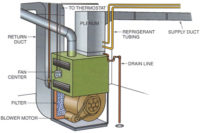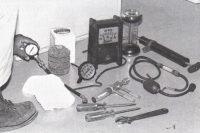Now, Bob’s company has promoted him to help train a new employee, right out of a school specializing in HVAC, just like Bob was. Bob is now Tim’s Btu Buddy. Tim is anxious to travel with Bob. Tim realizes that he is right out of school, with the theory and lab work that he accomplished in school, but still needs help. He knows that he worked with many of the components of the systems in the school, under ideal conditions with good light and air conditioning. Now it is into the field, sometimes under the house with poor lighting, or out on the rooftop in the sun, where the real action is. He is naturally and normally reluctant, but he has Bob to help guide him.
Tim and Bob have been sent on a service call to a new customer’s house. The homeowner has an unusual complaint. She said that she thinks she has a furnace problem because there is mold in her house. They don’t know what this can be all about.
When they arrived, they saw that the house is in a very nice neighborhood and is not an old house. They met the owner and asked her to explain what she meant by mold in the house.
The housewife said, “There seems to be mold on a lot of the furniture. It is on the surface of some of it. It is even under the dining room table. I ran into a friend that used to be in the HVAC business and explained what was going on with our house. He insisted that I contact someone and he recommended your company. I have relatives coming from out of town this weekend and I really need help because cold weather will be here. It is Monday. This needs to be solved in a hurry.”
Bob asked, “When did you first start noticing the mold?”
She responded, “Last winter it was bad. I had a service company out and they said my furnace was bad. We just kept operating all winter and it got worse. Now the heating season is starting and it is doing it again.”
Bob asked, “Do your windows ever sweat?”
She said, “Yes, every morning I have to wipe water off of the window sills. That takes a lot of time.”
Bob said, “Show me some of the mold and where the windows have been sweating.”
They went into the dining room and looked at some of the mold. Bob said, “This is light colored mold and isn’t very thick, a very slight coat. Looking at this window sill, I can see where water has been standing. Where is your furnace?”
She said, “Under the house in the crawl space.”
Bob and Tim got rigged up and went under the house for a look. Bob said, “Look at that flue pipe. It isn’t even connected. Someone knocked it down and didn’t bother to reconnect it. That can be very dangerous because the flue gases are just venting out under the house.”
Tim said, “It has apparently been operating for quite awhile. How can that be?”
Bob explained, “As you learned in school, gas furnaces give off carbon dioxide (CO2) and water vapor when they are burning efficiently. When the flame is oxygen starved, the burner will burn inefficiently with a lazy yellow flame (Figure 1) and the flue gases will be carbon monoxide (CO) which is an odorless, colorless gas that is not likely to be noticed until too late.”
Tim asked, “What would the symptoms be with CO2 in the air?”
Bob said, “All gas flames give off a slight odor of aldehyde in the burning process. The aldehyde is in the formaldehyde family. It is the odor that you can smell when cooking with gas. It is very slight. You should be able to smell it if you know what it is. If the flame is burning inefficiently, that odor may be a little more noticeable.
“The residents may notice more moisture in the air. If that moisture comes in contact with a surface that is below the dew point temperature, moisture will condense out of the air. That would be windows, cold water pipes, and maybe even the water tank that supplies the toilet with water, which will be from the city main and cold in the winter.”
Tim then asked, “What would the symptoms be if there was CO in the air?”
Bob said, “CO, or as most people would call it carbon monoxide, is a poisonous gas, even in small quantities. CO gas is accumulative in the human body and remains for some time, so being exposed for long periods of time to small amounts can cause damage. The persons will likely have headaches and with more exposure will become dizzy and possibly sick to their stomachs and will pass out after awhile and may not notice the progression of the problem.
“A friend of my family had a factory built and designed travel trailer with a factory installed gas furnace at his hunting lease. He and a friend were up hunting for the weekend and did not come home when they were supposed to. There were no cell phones then, so his wife rode up to the lease to check on them and found them sitting on the couch watching TV and they were dead. He was a doctor, and the CO slipped up on them. The furnace flue was found to be at fault.
“Never take a leaking flue lightly. It needs to be dealt with when discovered.”
Tim asked, “Why do you think this system didn’t harm the residents of this house?”
Bob said, “Well, it is obvious that the furnace was not venting CO under the house or at best someone would have been injured. Modern day gas furnaces mostly use ‘single port’ burners (Figure 2), which have large primary air intakes and large burner ports. If particles enter the air intake, they just burn off. Heavy dust does not accumulate in these burners like it did in the older small port burners (Figure 3).”
Tim asked, “What is the next step? It is going to be cold this week.”
Bob said, “The first thing we are going to do is shut this furnace off and remove the control wiring where it can’t be started until something is done. If you will notice, the furnace flue pipe is in such bad shape that it can’t be reconnected and the furnace is really rusty. We are going to give the heat exchanger a close visual look for signs of damage.”
They removed the cover to the burner compartment and looked at the heat exchanger above the burner.
Tim said, “This heat exchanger has rust holes above the burners in several places. This furnace is defective. It can’t be allowed to operate even if the flue is repaired.”
Bob and Tim removed the control wires to the furnace and taped them up and then went upstairs and explained to the housewife, “We cannot allow this furnace to operate in this condition. The furnace is in such bad shape that it is dangerous to you. We disconnected the controls and turned off the gas valve until something can be done to make this house safe. The moisture from the flue gases are the cause of your moisture problems, so repairing the system solves two problems, moisture and safety.”
She said, “I called my husband and there he comes down the street. Please explain this to him. He will understand it better than me.”
Bob explained the situation to the husband and then went on to say, “I believe the installation department can get right to work on this job. The weather is mild now. When it turns cold later in the week, it will get busy.”
The husband said, “I was hoping for a fix on this system, but from what you have explained, I think that we need to act. What do we do next?”
Bob said, “I will call for an estimator to come out and give you a written estimate, and the company will take it from there and handle the installation. The mold in your house is basically a clean up problem. When the humidity is reduced by operating the furnace with a good flue, the moisture will dissipate and be gone. If you are worried about the mold, you should contact a mold specialist for a solution.”
As they were riding away, Tim said, “Well, that went smooth. You went through the call and explanation like a pro. I think the customer picked up on how it was handled and made a good decision.”
Bob said, “Yes, the customer can follow the technician explanation when presented with a clear-cut set of facts and make the right decision. I have a feeling that he knows that our company is honest and fair.”
Publication date: 12/19/2011













